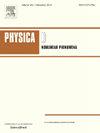The integrable nonlocal nonlinear Schrödinger equation with oscillatory boundary conditions: Long-time asymptotics
IF 2.7
3区 数学
Q1 MATHEMATICS, APPLIED
引用次数: 0
Abstract
We consider the Cauchy problem for the integrable nonlocal nonlinear Schrödinger equation subject to the step-like initial data: as and as , where and . The goal is to study the long-time asymptotic behavior of the solution of this problem assuming that is close, in a certain spectral sense, to the “step-like” function with . A special attention is paid to how affects the asymptotics.
具有振荡边界条件的可积非局部非线性Schrödinger方程:长时间渐近性
考虑可积非局部非线性Schrödinger方程iqt(x,t)+qxx(x,t)+2q2(x,t)q′(−x,t)=0的Cauchy问题,其初始数据为:q(x,0)→0为x→−∞,q(x,0)≃Ae2iBx为x→∞,其中A>;0, B∈R。目的是研究假设q(x,0)在一定谱意义上接近于“阶梯”函数q0,R(x)=0,x≤R,Ae2iBx,x>;R,且R>;0时,该问题解的长期渐近行为。特别注意了B≠0对渐近的影响。
本文章由计算机程序翻译,如有差异,请以英文原文为准。
求助全文
约1分钟内获得全文
求助全文
来源期刊

Physica D: Nonlinear Phenomena
物理-物理:数学物理
CiteScore
7.30
自引率
7.50%
发文量
213
审稿时长
65 days
期刊介绍:
Physica D (Nonlinear Phenomena) publishes research and review articles reporting on experimental and theoretical works, techniques and ideas that advance the understanding of nonlinear phenomena. Topics encompass wave motion in physical, chemical and biological systems; physical or biological phenomena governed by nonlinear field equations, including hydrodynamics and turbulence; pattern formation and cooperative phenomena; instability, bifurcations, chaos, and space-time disorder; integrable/Hamiltonian systems; asymptotic analysis and, more generally, mathematical methods for nonlinear systems.
 求助内容:
求助内容: 应助结果提醒方式:
应助结果提醒方式:


